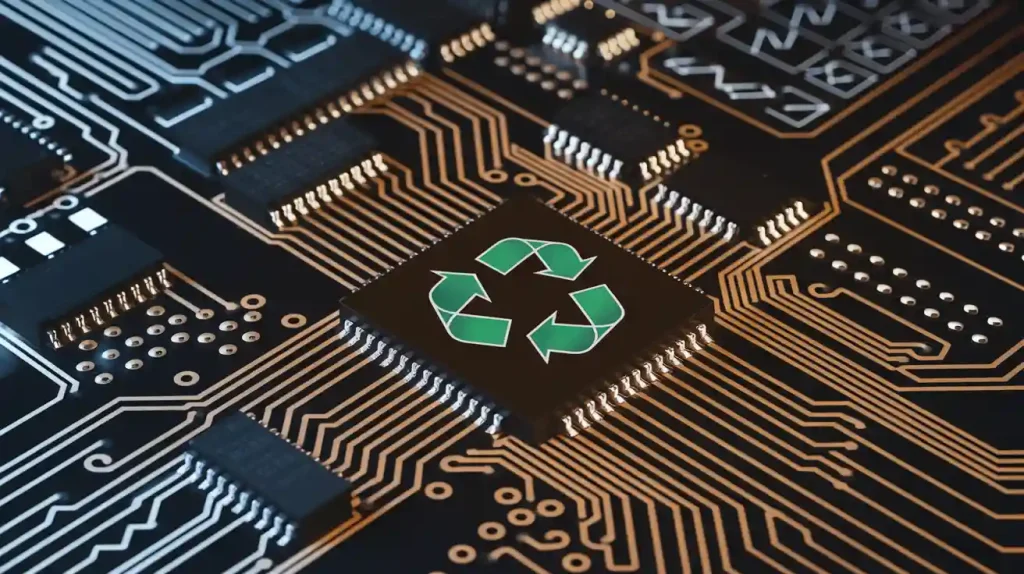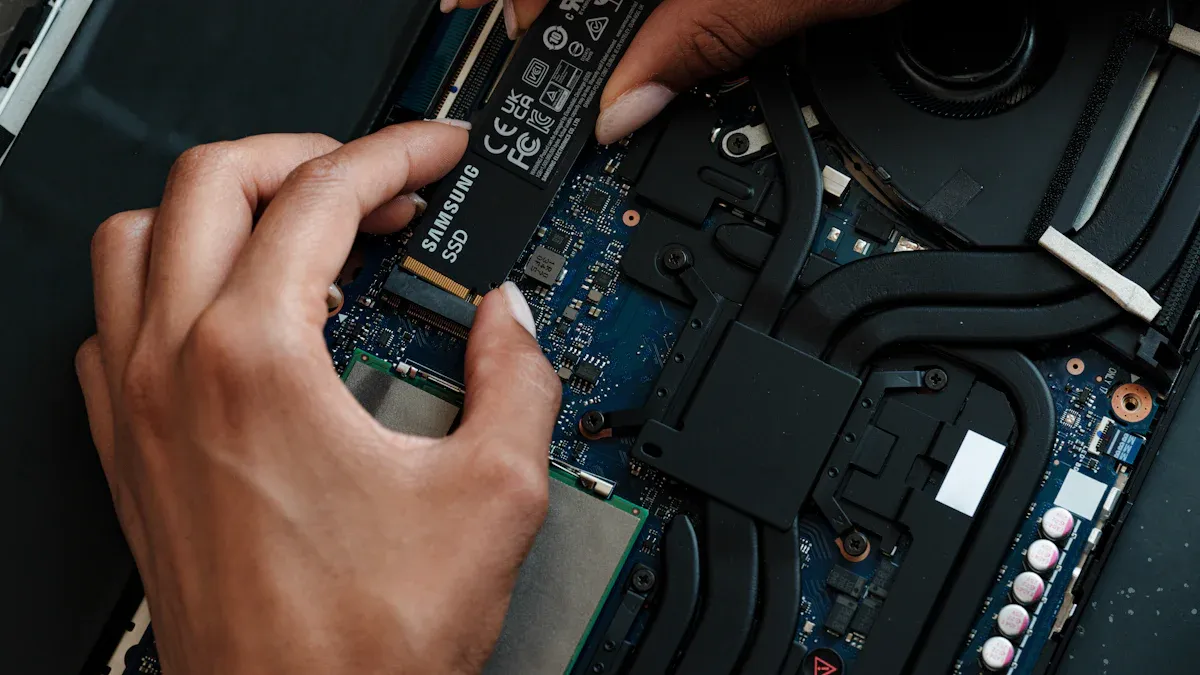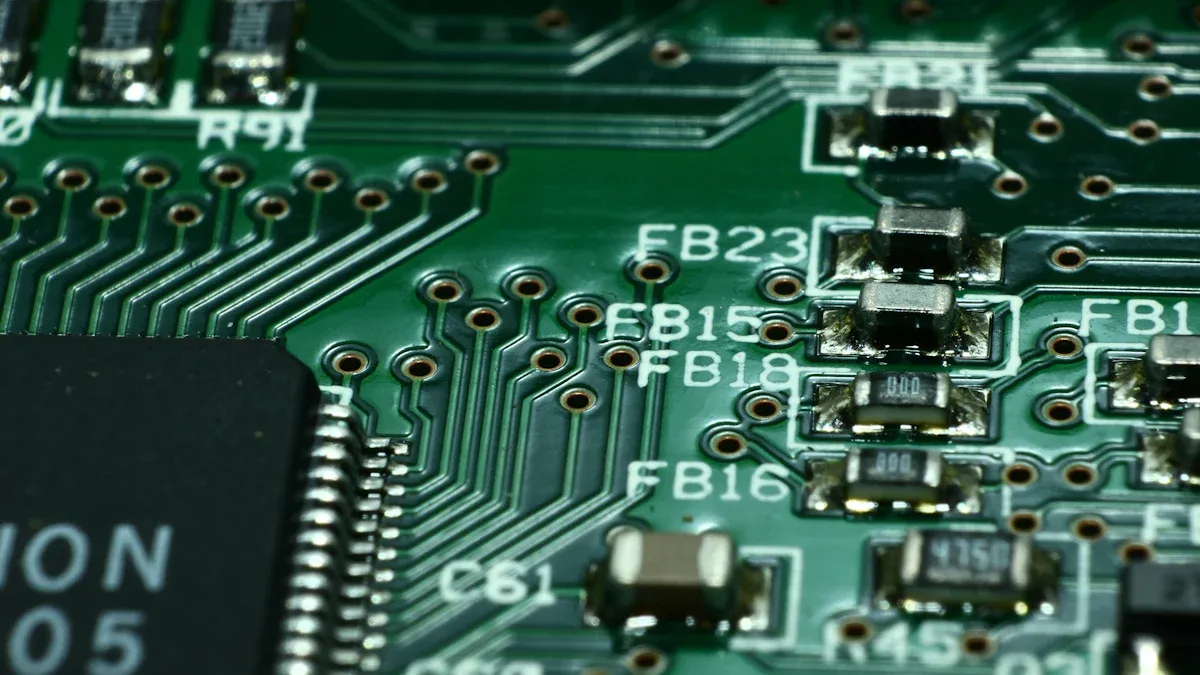What Are RoHS Compliance Standards for PCBs
RoHS compliance standards ensure the restriction of hazardous substances in electronic products. These standards aim to protect the environment and human health by limiting toxic materials like lead and mercury. For printed circuit boards (PCBs), compliance is critical. It guarantees safer products and aligns with global environmental regulations. As a manufacturer or designer, adhering to RoHS compliance helps you meet legal requirements, reduce toxic waste, and improve product safety. By choosing PCB RoHS compliant materials, you contribute to sustainable practices while enhancing the marketability of your electronics.
Key Takeaways
- RoHS rules limit harmful materials in electronics, making them safer.
- Using RoHS-approved materials in PCBs helps sell products worldwide.
- Following RoHS rules cuts toxic waste and keeps the planet cleaner.
- Using lead-free solder and working with safe suppliers is important.
- RoHS rules protect workers and earn trust from safety-conscious buyers.
Understanding RoHS Compliance Standards
What is RoHS?
RoHS, short for Restriction of Hazardous Substances, is a regulatory standard introduced by the European Union. It aims to limit the use of specific hazardous materials in electronic and electrical equipment. These materials include heavy metals like lead, mercury, cadmium, and hexavalent chromium. By restricting these substances, the RoHS directive seeks to reduce the environmental and health risks associated with the disposal and operation of electronic devices.
The regulation plays a critical role in ensuring that electronic products, including PCBs, meet strict safety and environmental standards. RoHS-compliant circuit boards are designed to minimize the release of toxic substances into the environment. This makes them safer for both consumers and workers involved in manufacturing. As a result, RoHS compliance has become a global benchmark for sustainable electronics production.
Why is RoHS compliance important for PCBs?
PCBs serve as the backbone of most electronic devices, making their compliance with RoHS standards essential. Non-compliant materials in PCBs can pose significant risks to human health and the environment. For instance, lead, a common hazardous material, can leach into soil and water during disposal, causing long-term contamination. RoHS-compliant PCBs eliminate such risks by adhering to strict material restrictions.
From a business perspective, RoHS compliance enhances the marketability of your products. Many countries and regions now require electronic devices to meet RoHS standards before they can be sold. By designing RoHS-compliant PCBs, you ensure that your products can compete in global markets. Additionally, compliance demonstrates your commitment to sustainability, which can improve your brand’s reputation and attract environmentally conscious consumers.
RoHS PCBs also contribute to safer workplaces. Manufacturing processes that avoid hazardous materials reduce the risk of exposure for workers. This not only protects their health but also minimizes potential liabilities for your business. In essence, RoHS compliance is not just a regulatory requirement; it is a step toward creating safer, more sustainable, and globally competitive electronic products.
Restricted Materials in RoHS-Compliant Circuit Boards
List of restricted substances.
RoHS-compliant circuit boards must adhere to strict guidelines that limit the use of hazardous materials. These restrictions aim to reduce environmental harm and protect human health. The following table outlines the key substances restricted under the Restriction of Hazardous Substances (RoHS) directive:
| Material | Description |
|---|---|
| Lead or Pb | Used for reducing the melting point of alloys; harmful to human health. |
| Hexavalent Chromium or Cr(VI) | Used for corrosion resistance; a severe carcinogen. |
| Mercury or Hg | Used in batteries; highly toxic and damages the nervous system. |
| Cadmium or Cd | Previously used in batteries; a severe carcinogen. |
| Polybrominated Biphenyls or PBBs | A flame retardant; harmful to the nervous system. |
| Polybrominated Diphenyl Ether or PBDE | Used for fire retardant properties; damages the nervous system and thyroid gland. |
These substances are commonly found in electronic components, including printed circuit boards. By eliminating them, manufacturers ensure compliance with RoHS standards and contribute to safer, more sustainable products.
Environmental and health risks of restricted materials.
The restricted materials in RoHS-compliant circuit boards pose significant risks to both the environment and human health. For example, lead and cadmium can leach into soil and water during disposal, contaminating ecosystems and endangering wildlife. Mercury, often used in batteries, can vaporize and pollute the air, leading to severe health issues for humans, such as damage to the nervous system.
Hexavalent chromium, a known carcinogen, is another hazardous material that threatens worker safety during manufacturing processes. Flame retardants like PBBs and PBDEs, while effective in preventing fires, release toxic chemicals that harm the thyroid gland and nervous system. These substances also persist in the environment, making their impact long-lasting.
By adhering to RoHS compliance, you help reduce these risks. RoHS-compliant PCBs not only minimize toxic waste but also promote safer workplaces and healthier ecosystems. This commitment to sustainability ensures that your products meet global environmental standards while protecting consumers and workers alike.
Common Non-Compliant Materials in PCBs
Examples of non-compliant materials.
Non-compliant materials in PCBs often include substances that fail to meet RoHS standards. These materials are typically hazardous and pose significant risks to health and the environment. For instance, lead is a common non-compliant material used in soldering processes. It enhances solder performance but is highly toxic. Cadmium, another example, was historically used in PCB components like connectors and switches. Its carcinogenic properties make it unsuitable for RoHS-compliant PCB production.
Mercury, though less common today, can still be found in certain PCB applications, such as switches or relays. This material is extremely harmful to the nervous system. Hexavalent chromium, used for corrosion resistance, is another non-compliant material. It is a known carcinogen and poses severe risks during manufacturing and disposal. Flame retardants like polybrominated biphenyls (PBBs) and polybrominated diphenyl ethers (PBDEs) are also non-compliant. These substances, while effective in preventing fires, release toxic chemicals that persist in the environment.
Risks of using non-compliant materials.
Using non-compliant materials in PCBs can lead to serious consequences. From an environmental perspective, these materials contribute to pollution and toxic waste. For example, lead and cadmium can leach into soil and water, contaminating ecosystems. Mercury vaporizes easily, polluting the air and causing long-term health issues for humans and animals.
Non-compliance also affects your business. Products containing hazardous materials cannot be sold in regions that enforce RoHS compliance. This limits your market reach and damages your brand reputation. Additionally, manufacturing with non-compliant materials increases risks for workers. Exposure to substances like hexavalent chromium can lead to severe health problems, including cancer. By avoiding these materials, you ensure safer workplaces, protect the environment, and meet global regulatory standards.
Steps to Ensure PCB RoHS Compliant
Designing RoHS-compliant PCBs
Creating a RoHS-compliant PCB begins with selecting the right materials. Choose base materials that meet RoHS directives while ensuring the long-term reliability of the printed circuit boards. Consider the glass transition temperature (Tg) of these materials, as it impacts their performance during thermal cycling. Additionally, use flame retardants that comply with both RoHS and WEEE directives to enhance safety and compliance.
Lead-free solder plays a critical role in RoHS-compliant PCB manufacturing. It requires higher temperatures during soldering, so you must use solder flux designed to withstand these conditions. Implement soldering techniques that accommodate these elevated temperatures to maintain the integrity of the PCB. Training your personnel in IPC standards ensures proper soldering practices and adherence to RoHS compliance in PCB manufacturing.
Testing and Certification Processes
Testing and certification are essential steps in ensuring your PCB meets RoHS standards. Begin with a thorough documentation review, including the Bill of Materials, assembly drawings, and material declarations. Conduct an audit of your manufacturing processes to verify compliance with restricted substances.
On-site testing, such as portable XRF (X-ray fluorescence) analysis, helps determine the presence of hazardous materials in your RoHS PCB board. Once your PCB passes these tests, obtain a RoHS certification to confirm compliance. This certification not only validates your efforts but also enhances the marketability of your RoHS-compliant PCB.
Partnering with RoHS-Compliant Suppliers
Collaborating with suppliers who prioritize RoHS compliance simplifies your manufacturing process. Choose suppliers that provide RoHS PCBs and components, ensuring that all materials meet regulatory standards. Verify their certifications and request documentation to confirm their adherence to RoHS directives.
Building strong relationships with compliant suppliers reduces the risk of non-compliance and streamlines your production. It also ensures that your products align with global environmental standards, enhancing your reputation and opening doors to international markets. By partnering with reliable suppliers, you can focus on delivering high-quality, RoHS-compliant PCB manufacturing.
Environmental and Practical Benefits of RoHS-Compliant PCBs
Reduction of toxic waste and pollution
RoHS-compliant PCBs play a vital role in reducing toxic waste and pollution. By eliminating hazardous materials such as lead, mercury, and cadmium, you help prevent these substances from contaminating the environment. When electronic devices containing non-compliant materials are discarded, they often end up in landfills. Over time, these substances leach into the soil and water, causing long-term damage to ecosystems and wildlife.
Switching to RoHS PCBs ensures that your products meet the highest environmental standards. For example, using lead-free surface finishes in PCB manufacturing significantly reduces the release of harmful toxins during production and disposal. This shift not only minimizes pollution but also aligns your business with global sustainability goals. By adopting RoHS compliance, you contribute to a greener future while protecting natural resources for future generations.
Enhanced safety for workers and consumers
RoHS compliance enhances safety for both workers and consumers by eliminating exposure to hazardous materials during manufacturing and product use. Workers in PCB production facilities often handle substances like hexavalent chromium and flame retardants, which pose severe health risks. By adhering to the RoHS directive, you create a safer workplace where employees are not exposed to these harmful substances.
For consumers, RoHS-compliant products offer peace of mind. Electronics free from hazardous materials reduce the risk of health issues caused by prolonged exposure to toxic substances. For instance, mercury and cadmium, commonly found in non-compliant products, can harm the nervous system and other vital organs. By choosing RoHS-compliant certification for your PCBs, you ensure that your products are safe for end-users, fostering trust and loyalty among your customers.
Marketability and global trade opportunities
RoHS compliance significantly boosts the marketability of your products and opens doors to global trade opportunities. Many countries, including those in the European Union, require electronic products to meet RoHS standards before they can be sold. By manufacturing RoHS PCBs, you ensure that your products comply with these regulations, allowing you to access international markets without legal barriers.
Additionally, RoHS-compliant products appeal to environmentally conscious consumers who prioritize sustainability. Highlighting the green benefits of your PCBs can enhance your brand image and attract a broader customer base. Furthermore, obtaining RoHS-compliant certification demonstrates your commitment to quality and environmental responsibility, giving you a competitive edge in the electronics industry. By aligning with RoHS standards, you position your business for long-term success in a rapidly evolving global market.
RoHS compliance for PCBs is more than a regulatory requirement; it is a commitment to sustainability and safety. By adhering to these standards, you reduce environmental harm, protect human health, and ensure your products meet global market demands.
Tip: Adopting RoHS standards not only enhances your brand’s reputation but also positions your business as a leader in sustainable electronics.
Take the initiative to design RoHS-compliant PCBs, partner with certified suppliers, and prioritize testing. These steps will help you create safer, eco-friendly products while unlocking new opportunities in international markets.
FAQ
What does RoHS compliance mean for PCBs?
RoHS compliance ensures that PCBs meet the Restriction of Hazardous Substances directive. It limits the use of toxic materials like lead and mercury in circuit boards. This compliance guarantees safer products and aligns with global environmental standards.
How can you identify RoHS-compliant boards?
You can identify RoHS-compliant boards by checking for certifications or labels indicating compliance. Manufacturers often provide documentation confirming adherence to the restriction of hazardous substances compliance standards.
Are RoHS-compliant PCBs more expensive?
RoHS-compliant PCBs may have slightly higher production costs due to the use of lead-free materials and additional testing. However, the long-term benefits, such as global market access and reduced environmental impact, outweigh the initial expense.
Why is lead-free solder important in RoHS-compliant boards?
Lead-free solder is crucial because it eliminates the health and environmental risks associated with lead. It ensures that PCBs meet RoHS standards while maintaining product safety and reliability.
Can non-compliant PCBs still be used?
Non-compliant PCBs cannot be sold in regions enforcing RoHS regulations. Using them may result in legal penalties and harm your brand’s reputation. Transitioning to RoHS-compliant boards ensures compliance and marketability.






















